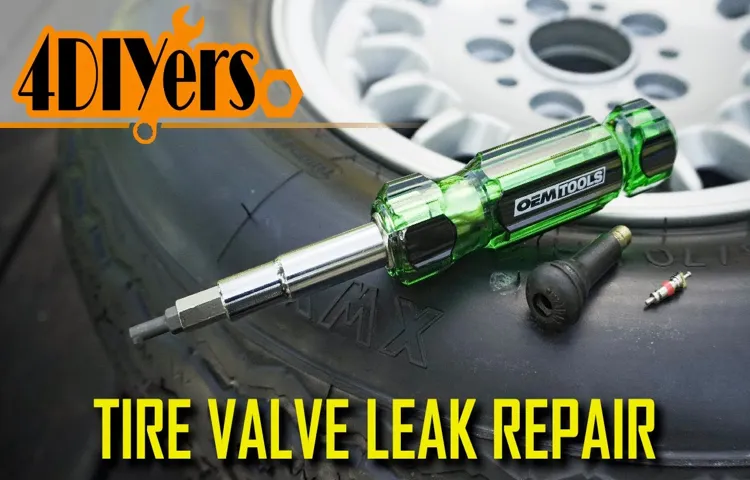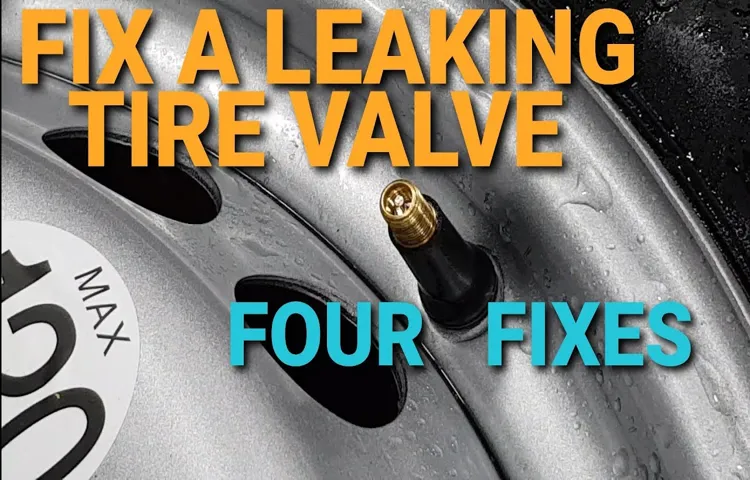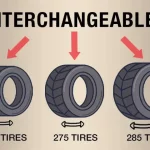Dealing with a leaking tire valve can be frustrating, but luckily, it’s a pretty common problem that can be easily fixed. If you’ve noticed that your tires are losing air more quickly than usual, it’s likely due to a damaged or faulty valve stem. The valve stem plays a critical role in maintaining the proper air pressure in your tires, so it’s essential to keep it in good condition.
Fortunately, fixing a leaking tire valve is a straightforward process that you can do at home with some basic tools and a little know-how. In this blog post, we’ll walk you through the steps to fixing a leaking tire valve and get your wheels back to their optimal air pressure.
Table of Contents
Identify the Problem
If you find yourself with a leaking tire valve, it’s important to identify the problem so you can fix it as soon as possible. One common cause of a leaking tire valve is a damaged valve stem. This can be caused by age, wear and tear, or improper installation.
Another potential issue is a damaged valve cap, which can allow air to escape from the valve stem. In some cases, the valve core may also be damaged or worn, preventing it from sealing properly and allowing air to leak from the tire. Whatever the cause of your leaking tire valve, it’s important to address the issue promptly, as driving with a leaking tire can be extremely dangerous and can cause serious damage to your vehicle.
With the right tools and a little know-how, however, fixing a leaking tire valve can be a relatively simple and straightforward process, so don’t delay in getting started.
Check Tire Pressure
Have you ever noticed your car feeling a little off? Maybe it’s pulling to one side or you’re hearing some strange noises. It could be time to check your tire pressure! Low tire pressure is a common issue that can cause a variety of problems for your vehicle. But, how do you identify the problem? First, take a look at your tires.
Do they look deflated or uneven? This could be a sign that your tire pressure is too low. Another indicator is your car’s handling. If it feels like it’s swaying or drifting, especially on turns, it could be a sign of low tire pressure.
Remember, low tire pressure can also cause your tires to wear out faster, so it’s important to address the issue as soon as possible. So, when in doubt, check your tire pressure and make sure you’re driving safely on the road.

Look for Punctures or Tears
When it comes to bike maintenance, one common issue cyclists face is dealing with punctures or tears in their tires. Identifying the problem early on is crucial to prevent further damage and ensure your safety on the road. Start by looking for any visible signs such as cracks, cuts, bulges, or debris embedded in the tire.
You can also use your fingers to feel for any rough areas or blisters on the surface. If you notice any damage on the tire, it’s best to replace it as soon as possible to avoid a sudden blowout. In some cases, you may be able to patch up small holes or tears using a tire repair kit, but this should only be seen as a temporary fix.
Remember that prevention is key, so be sure to inspect your tires regularly and keep them properly inflated to avoid unnecessary wear and tear. By being proactive about bike maintenance, you can enjoy a smooth and safe ride every time.
Tools You Will Need
If you’re wondering how to fix a leaking tire valve, there are a few tools you’ll want to have on hand before you get started. Firstly, you’ll need a tire pressure gauge to determine the current pressure of your tire. You’ll also need a valve stem removal tool to remove the leaking valve from the tire.
Additionally, you’ll need a replacement valve stem to put in its place. Lastly, you’ll want to have a valve core removal tool to remove the core from the leaking valve and put it in the replacement valve stem. These tools can be found at most auto supply stores and are relatively inexpensive.
With these tools on hand, you’ll be well-equipped to fix a leaking tire valve and get back on the road in no time.
Valve Core Removal Tool
When it comes to maintaining your bike, having the right tools is essential. One tool that often gets overlooked but is a real lifesaver is a valve core removal tool. This tool allows you to remove the valve core from your bike’s tires effortlessly, making it easier to add or release air, change out your tires or tubes, or even inject sealant into your tires.
Valve core removal tools come in a variety of shapes and sizes, so be sure to choose one that fits the valve on your specific bike. The right tool can save you time and frustration, making it a worthwhile investment for any bike owner. Don’t forget to add a valve core removal tool to your toolkit today!
Tire Pressure Gauge
When it comes to maintaining your vehicle’s tires, having a reliable tire pressure gauge is essential. To check the pressure in your tires, you will need a tire pressure gauge, which is a handheld device that measures the air pressure inside the tire. Not all tire pressure gauges are created equal, so it’s important to choose one that is both accurate and easy to use.
Digital tire pressure gauges are a popular choice because they provide precise readings and often feature backlight LCD displays for easy reading. Alternatively, analog gauges work well and are often less expensive. Whichever type of tire pressure gauge you choose, ensure you invest in a high-quality brand that will last a long time.
Keeping an accurate and reliable tire pressure gauge in your vehicle can help you save money on fuel, improve your vehicle’s handling, and promote overall safety on the road.
Wrench
When it comes to repairing things, having the right tools can make all the difference. One essential tool that you will definitely need is a wrench. A wrench is a handheld tool that is used for turning bolts, nuts, and other fittings to either tighten or loosen them.
It is an incredibly versatile tool, and you’ll find yourself using it for a variety of tasks. The most common types of wrenches are adjustable wrenches and socket wrenches, and both have different uses. An adjustable wrench has a movable jaw that can be adjusted to fit different sizes of nuts and bolts.
Socket wrenches, on the other hand, are designed to fit over a specific size of nut or bolt. Whichever type of wrench you choose, make sure that you get a good quality one. You don’t want your wrench to slip or strip the fittings you are working on.
Overall, having a good quality wrench in your toolbox can make your repairs easier and more efficient, ultimately saving you time and money in the long run.
Steps to Fix the Leak
If you find that your tire is leaking, don’t worry, it can be fixed! One common cause of a leaking tire is a damaged valve stem. To fix this problem, the first step is to remove the damaged valve stem using a valve stem removal tool. Next, you’ll need to insert a new valve stem into the hole using a valve stem installation tool.
After the new valve stem is secure, inflate the tire to the recommended pressure and check for any signs of leakage. You may also want to use a tire sealant to fill any leaks that may have occurred. If the tire continues to leak after attempting to fix the valve stem, it’s important to have a professional mechanic inspect the tire for any other possible causes of the leak.
By taking these steps, you can ensure your tire is functioning properly and safely.
Remove the Valve Core
When fixing a leak, the first step is to remove the valve core. This crucial step allows you to access the inner workings of the valve and identify the source of the problem. But how do you remove the valve core? First, you need to locate the valve stem.
Once you’ve found it, use a valve core removal tool (which can be purchased at any auto parts store) to unscrew the core counterclockwise. Be sure to keep track of the core, as it’s small and easy to lose. With the core removed, you can now inspect the stem for damage or wear and replace any necessary parts.
So, next time you have a leaky valve, remember to start by removing the core and taking a closer look at the problem. Happy fixing!
Inspect the Valve Core and O-Ring
If you have a leaking tire, it’s important to inspect the valve core and o-ring to identify the source of the leak. The valve core is the small metal piece at the center of the valve stem, while the o-ring is the rubber ring that creates a seal between the valve stem and the valve cap. Inspect both carefully for any signs of damage, cracks, or wear and tear.
If the valve core is damaged or worn, you’ll need to replace it with a new one. Similarly, if the o-ring is damaged, it’s crucial to replace it to ensure a proper seal. Don’t forget to use a valve core tool to remove and install the valve core as this will help prevent damage.
By following these simple steps, you can fix the leak and ensure your tire stays inflated for longer. Remember, regular maintenance is crucial to keeping your tires in good condition, so always keep an eye out for any signs of wear and tear.
Replace the O-Ring
If you’re experiencing a leak in your plumbing system, the first thing you should do is investigate the issue. After doing a thorough check, you may find that the most likely culprit is a damaged or worn-out O-ring. The O-ring is a small rubber ring that fits around the base of your faucet or pipe and helps to prevent leaks.
Replacing the O-ring is a straightforward process, but it does require some basic plumbing knowledge. First, turn off the water supply to the affected area and then unscrew the faucet or pipe. Remove the old O-ring and replace it with a new one that is the same size.
Make sure to lubricate the new O-ring with petroleum jelly before reinstalling the faucet or pipe. Finally, turn the water supply back on and check for any remaining leaks. By taking these steps, you can fix the leak quickly and easily without the need for an expensive plumber.
Reinstall the Valve Core
After locating the leak in your tire, the next step is to fix it by reinstalling the valve core. Simply unscrew the valve cap and remove the core using a valve core remover tool. Once the old core is removed, take a new one and screw it back into place using the same tool.
Make sure to tighten it firmly, but not too tight as it may damage the valve stem. After installing the new core, check the tire pressure and inflate it to the recommended level. This simple fix should stop the leak and allow you to get back on the road safely.
Remember to periodically check your tires for any signs of wear and tear, as well as maintaining proper inflation levels to avoid future issues. With this in mind, you can ensure that your trips are always smooth and worry-free.
Check Tire Pressure and Reinflate
When you notice that your car’s tire pressure is low, it’s essential to take action as soon as possible. Ignoring this issue could lead to a flat tire or even a blowout, which is incredibly dangerous when you’re driving. The first step is to locate the leak by inspecting the tire visually or using soapy water and a spray bottle.
Then, remove the object that caused the puncture, if it’s still there, before inflating the tire to the correct pressure. The recommended PSI level can be found in your vehicle’s owner manual or on the tire itself. Once you’ve reinflated the tire, check it again for leaks and monitor it for the next few days.
As a general rule of thumb, you should aim to check your car’s tire pressure at least once a month to prevent unexpected problems on the road. Always remember that maintaining the right tire pressure can help improve fuel efficiency and prolong the life of your tires, so it’s worth the effort!
When to Seek Professional Help
If you notice your tire valve is leaking, it’s best to seek professional help right away. While it may be tempting to try and fix the issue yourself, it’s important to consider the potential risks and dangers that come with tampering with your vehicle. A leaking tire valve can cause your tire to lose pressure, which can lead to a blowout – and that’s a serious safety hazard that you want to avoid at all costs.
Professional mechanics have specialized tools and experience to diagnose and repair tire valve issues quickly and efficiently. Don’t take any chances with your safety on the road – leave the job to the pros and get your tire valve fixed properly.
Multiple Leaks or Damage to Tire
If you notice multiple leaks or damage to your tire, it’s important to seek professional help right away. Continuing to drive on a damaged tire can be incredibly dangerous and potentially lead to a blowout while you’re on the road. While it may be tempting to try and patch the tire yourself, this can lead to further complications and could end up costing you more money in the long run.
A professional mechanic will be able to assess the damage and determine the best course of action to repair or replace the tire. Remember, the safety of you and your passengers should always take priority over any DIY attempts. Don’t hesitate to reach out for help if you suspect an issue with your tire.
Unable to Remove Valve Core
If you find yourself unable to remove a valve core, it’s time to seek professional help. Often times, attempting to remove a valve core without the proper tools or experience can result in damaging the valve stem or piercing the tire, leading to costly repairs. Instead, take your vehicle to a licensed mechanic who can safely remove the valve and replace it if necessary.
Remember, DIY repairs can be tempting, but in some instances, it’s best to entrust the job to a professional. By doing so, you can save yourself time, money, and the potential of causing further damage. Trust the experts to get the job done right.
Maintaining Good Tire Health
Finding a leaking tire valve can be frustrating, but it’s an issue that needs to be addressed to maintain good tire health. A good starting point is to inspect the valve stem, which is located on the inner side of the tire. Sometimes, a leaking valve can be caused by dirt or debris around the valve stem.
So, the first step is to clean the area around the valve stem with a damp cloth. If that doesn’t resolve the issue, it may be necessary to replace the valve stem altogether. It’s essential to get this looked at by a professional, as it’s not always easy to identify which valve is leaking.
Remember that ignoring a leaking tire valve can be dangerous, as it can increase the risk of a flat tire or blowout. So, it’s necessary to fix the problem as soon as possible for your safety.
Regularly Check Tire Pressure
Maintaining Good Tire Health: Regularly Checking Tire Pressure Keeping your car’s tires in good condition is crucial to ensure your safety on the road. The simplest yet most essential way to maintain good tire health is to regularly check your tire pressure. Proper tire pressure directly affects the traction, fuel efficiency, and longevity of your tires.
Underinflated tires can cause heat buildup, tire damage, and poor handling, while overinflated tires can make your ride feel rough and decrease your tire’s lifespan. The ideal tire pressure is stated in your car’s manual or on a sticker found on the driver’s side doorjamb. Make sure to follow these guidelines and check your tire pressure every month or before long drives.
Investing in a quality tire gauge can help you accurately measure and adjust your tire pressure, giving you peace of mind on the road. So, take the necessary steps to maintain your tire pressure and ensure that your tires are in good condition for a safe and smooth drive.
Avoid Over-inflating Tires
If you want to maintain good tire health, avoiding over-inflating your tires is crucial. Over-inflated tires can cause a bumpy and uncomfortable ride, reduce traction, and decrease fuel efficiency. Additionally, over-inflated tires are more prone to bursting, which can lead to dangerous situations on the road.
It’s important to check your tire pressure regularly and keep it at the recommended level for your vehicle. Don’t rely solely on the pressure stated on the tire itself, as this may not be the optimal pressure for your specific car model. Keeping your tires properly inflated not only ensures a safer and smoother ride, but also extends the overall lifespan of your tires.
So take the time to check your tire pressure and avoid the potential hazards of over-inflated tires.
Avoid Driving on Damaged Roads
Maintaining good tire health is essential when it comes to avoiding driving on damaged roads. Your car’s tires are the only point of contact between the vehicle and the road, which is why they play a crucial role in ensuring your safety while driving. Regular tire maintenance is necessary to avoid any potential accidents caused by worn-out or damaged tires.
You should check your car’s tire pressure and tread depth at least once a month. Driving on under-inflated tires can make them wear out faster and can also lead to lower fuel efficiency. Similarly, driving on bald tires can increase the risk of hydroplaning and can result in poor vehicle handling.
So, it’s vital to replace your car’s tires when they become worn out or damaged. Not only will this keep you safe on the road, but it will also improve your car’s performance and fuel economy. Remember, maintaining good tire health is the key to a safe and smooth drive on any road.
Check Tires for Wear and Tear
Maintaining Good Tire Health Maintaining good tire health is crucial for the overall safety of your vehicle, and checking your tires for wear and tear is an essential part of this process. Regular inspections can help detect any issues before they become severe problems. As a vehicle owner, you should keep an eye on tire tread depth, which helps ensure proper traction on the road.
Low tread depth can reduce your control over the vehicle, especially in adverse weather conditions. Additionally, make sure to check for any bulges or cracks on the sidewalls, which could be a sign of tire damage that may lead to a blowout while driving. Keeping your tires inflated to the recommended level will also optimize fuel efficiency and extend the tire’s lifespan.
With proper maintenance, your tires will last longer, perform better, and provide a safer driving experience. Remember, tires are the only contact points between your vehicle and the road, and keeping them in good condition is essential for your safety and the safety of others on the road.
Conclusion
In summary, fixing a leaking tire valve is as easy as ABC – Assess the issue, Bring the right tools, and Check the valve for any leaks. With a little bit of patience and a steady hand, you can quickly solve the problem and get back on the road without any worries. So put on your thinking cap, grab your toolbox and get ready to show that leak who’s boss!”
FAQs
What causes a leaking tire valve?
There are several reasons why a tire valve can leak, such as a damaged valve stem, corroded valve core, or loose valve cap.
Can a leaking tire valve be fixed?
Yes, a leaking tire valve can be fixed by replacing the valve stem, core, or cap. It is best to have a professional mechanic do the repair for you.
How do I know if my tire valve is leaking?
You may notice that your tire is losing air pressure faster than usual, or you may hear a hissing sound coming from the tire valve. You can also do a visual inspection and look for any signs of damage or corrosion.
How often should I check my tire valves for leaks?
It is recommended to check your tire valves for leaks at least once a month. This will help ensure that your tires are properly inflated and prevent any potential safety hazards on the road.
Can a leaking tire valve cause a flat tire?
Yes, a leaking tire valve can cause a flat tire if left unattended. It is important to get any leaks fixed as soon as possible to avoid any potential accidents or damage to your vehicle.
What is the cost to fix a leaking tire valve?
The cost to fix a leaking tire valve can vary depending on the extent of the damage and the type of repair needed. It is best to get a quote from a professional mechanic.
How can I prevent tire valve leaks?
You can prevent tire valve leaks by properly maintaining your tires, checking the air pressure regularly, and replacing any damaged or worn out valve stems, cores, or caps.



